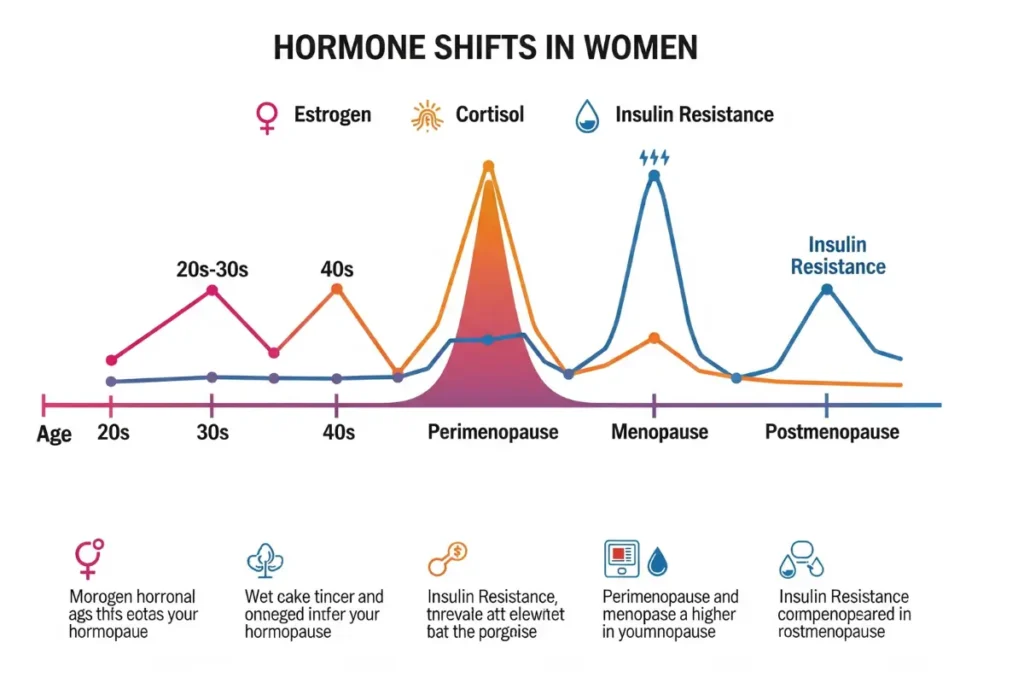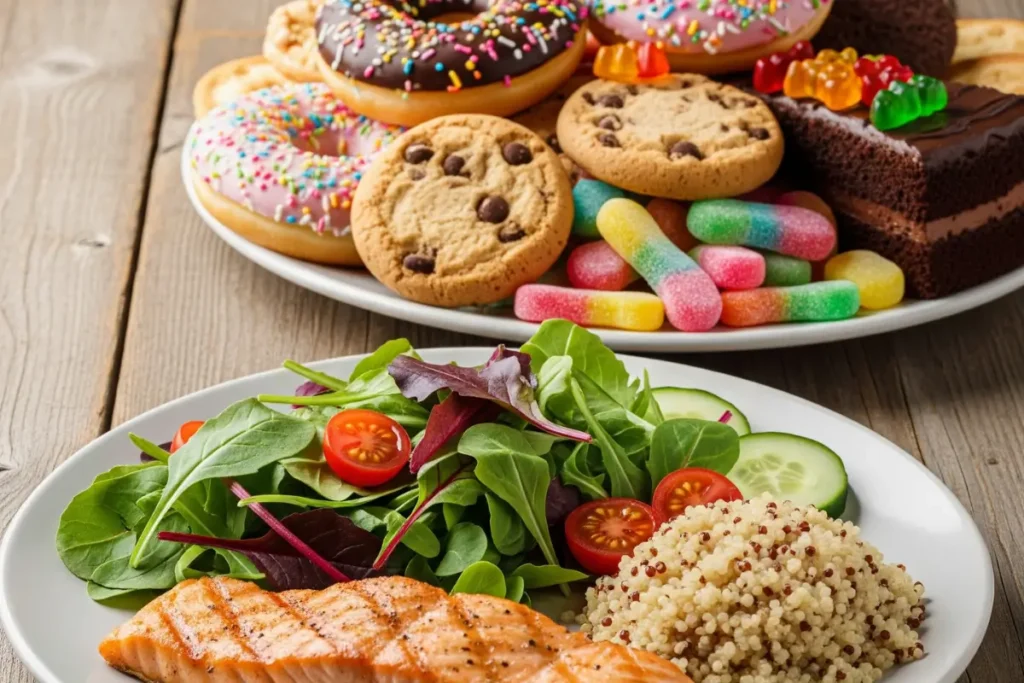
Introduction: Why the Scale Feels Different After 40
You’ve been eating the same way, moving the same way — maybe even trying harder than before. And yet, the scale creeps upward, your jeans feel tighter, and that stubborn belly fat refuses to budge. This is one of the most common frustrations women share with doctors: “I’m doing everything right, but my body won’t cooperate anymore.”
The truth is, weight gain after 40 is less about discipline and more about hormones. During perimenopause and menopause, hormonal fluctuations change how your body burns calories, stores fat, and even how hungry you feel [Harvard Health].
This guide will help you understand why this happens — and more importantly, what you can do about it.
Why Weight Gain After 40 Feels Different
Many women say, “I haven’t changed my eating, but I’m gaining weight anyway.” That’s because after 40, your body operates under new rules.
Hormone fluctuations disrupt fat storage.
- Estrogen drops shift fat storage from hips/thighs to the belly [Mayo Clinic].
- Progesterone decline contributes to water retention and bloating.
Muscle mass decreases naturally.
- Women lose 3–8% of muscle per decade after 40, accelerating after menopause [NIH].
Stress and sleep struggles amplify the problem.
- Cortisol spikes signal your body to store fat instead of burning it [Cleveland Clinic].
Insulin resistance rises.
- Reduced estrogen impairs insulin sensitivity, increasing fat storage [Endocrine Society].
Thyroid changes slow metabolism.
- Hypothyroidism is common in midlife women and often overlaps with menopause symptoms [American Thyroid Association].
Causes of Hormonal Weight Gain in Perimenopause and Menopause

Estrogen Decline and the Menopause Belly
Estrogen regulates fat distribution, insulin sensitivity, and appetite. When it declines:
- Fat redistributes to the abdomen.
- Visceral fat increases disease risk.
- Hunger and cravings may rise.
This is why menopause belly fat is so stubborn. [Mayo Clinic]
Cortisol and Stress-Driven Weight Gain
Chronic stress elevates cortisol, which:
- Increases abdominal fat storage.
- Breaks down muscle (slowing metabolism).
- Increases cravings for sugar and fat.
This explains the “cortisol belly” many women develop in their 40s. [Cleveland Clinic]
Muscle Loss and Metabolism Slowdown
Without intervention, muscle mass declines each decade after 40. Less muscle means:
- Slower calorie burn.
- Higher risk of fat gain.
- Lower strength and energy.

Resistance training is the only way to reverse sarcopenia.
Insulin Resistance After 40
As estrogen drops, cells become less responsive to insulin. This leads to:
- Higher blood sugar levels.
- Easier fat storage.
- Increased fatigue and cravings.

A key driver of perimenopause sudden weight gain. [Endocrine Society]
Thyroid Function Shifts
An underactive thyroid slows metabolism, often going undiagnosed in midlife women.
- Symptoms: fatigue, weight gain, thinning hair, dry skin.
- Full thyroid panels (TSH, T3, T4) should be discussed with your doctor. [American Thyroid Association]
Signs of Hormonal Weight Gain

- Sudden Onset: Weight gain appears seemingly overnight.
- Belly Fat: Fat shifts from hips to abdomen.
- Exercise Resistance: Same diet + workouts stop working.
- Other Menopause Symptoms: Hot flashes, night sweats, fatigue, or mood swings.
- Cortisol Belly: Round, deep abdominal fat difficult to pinch.
These patterns are distinct from regular age-related weight gain.
How to Stop Menopause Weight Gain: A Step-by-Step Framework
1. Nutrition: The Menopause Diet Framework
- Protein First (25–30g/meal): Preserves muscle, boosts metabolism.
- Fiber + Veggies: Stabilize blood sugar and support gut health.
- Carb Timing: Save complex carbs for after workouts.
- Healthy Fats: Avocado, nuts, olive oil, fatty fish for hormone balance.
2. Exercise: Strength + Movement Strategy
- Strength Training 2–3x/week: Essential for muscle and metabolism.
- Daily Walking (7,000–8,000 steps): Improves insulin sensitivity.
- HIIT (1–2x/week): Targets visceral fat and improves cardiovascular health.
3. Stress Reset
- Yoga, meditation, or breathwork: Lowers cortisol.
- 10-minute breaks daily: Prevents chronic stress buildup.
- Boundaries: Reducing overcommitments is as powerful as exercise.
4. Sleep Optimization
- Aim for 7–8 hours nightly.
- Use a cool, dark environment.
- Limit screen time 1 hour before bed.
Poor sleep disrupts ghrelin/leptin, fueling hunger and cravings.
5. Supplement Support (Evidence-Based)
- Vitamin D + Calcium: Bone + metabolic health. [NIH]
- Magnesium: Sleep + blood sugar balance. [NIH]
- Omega-3s: Reduce inflammation. [Harvard School of Public Health]
- Probiotics: Improve gut health and reduce inflammation.
- Berberine: Supports insulin sensitivity. [NCBI]
5-Day Menopause Diet
Portions can be adjusted to appetite and goals. Emphasize protein (25–30 g/meal) and fiber. Approximate daily calories: 1,600–1,900 depending on portion size.
| Day | Breakfast | Lunch | Dinner | Snack | Why It Helps |
|---|---|---|---|---|---|
| 1 | Eggs + spinach + avocado | Chicken–quinoa salad (olive oil) | Salmon, broccoli, sweet potato | Greek yogurt + berries | Protein steadies blood sugar levels; omega-3s reduce inflammation |
| 2 | Protein smoothie (berries, spinach) | Salmon bowl + greens | Turkey chili | Almonds | Protein + fiber = satiety; supports weight management |
| 3 | Chia pudding (unsweetened milk) | Chili leftovers | Chicken stir-fry + cauliflower rice | Apple + almond butter | Fiber + smart carbs blunt glucose spikes |
| 4 | Greek yogurt + nuts/seeds | Tuna lettuce wraps | Lean steak + asparagus, side salad | 2 boiled eggs | Preserves muscle for long-term metabolism |
| 5 | Veggie omelet | Steak + salad | Shrimp skewers + zucchini noodles (pesto) | Cottage cheese + cucumber | Balanced fat/protein for cravings control |